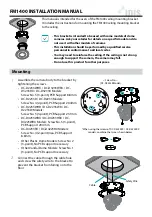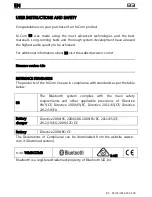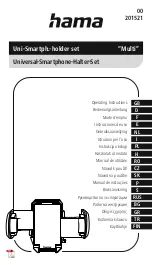
AMER-EN-TM-ODY July 2021
www.odysseybattery.com
below as an example of recharging a battery rated at 100 amp-hours from various depths of discharge
using a 10-amp constant current charger.
Temperature Compensation of Charge Voltages
Proper charging of all AGM
2
batteries requires temperature compensation of the charge voltage. This
is especially true in float applications where the batteries are on-charge constantly. The temperature
compensation coefficient is approximately ±18 mV per °C variation from 25°C per 12-volt battery.
Temperature and charge voltage are inversely related. Therefore, charge voltage must be reduced as
temperatures increase and charge voltage must be increased as temperatures decrease. Regardless
of temperature, the minimum charge voltage is 13.2 volts as lower voltages will damage the battery
grids and shorten life.
Recovering a Severely Discharged Battery
Many commercially available chargers must detect a certain minimum voltage for the charging process
to start. This is a common safety feature to prevent using a 12 volt charger on a 6 volt battery.
Chargers of this type are unable to charge a battery that has been severely over-discharged. For
example, a 12-volt charger might not start the charging process if the battery connected to it has an
OCV of 5 volts. Depending on the size of the battery, there are two ways to try to recover the battery.
• For batteries used in starting applications, the alternator can be used to recharge the battery after
jump-starting the battery to start the vehicle.
• For batteries not used in starting applications, a second battery that is known to be at a high state
of charge can be connected to the discharged battery in parallel. Refer to
Section IV, B (Battery
Sketch 2)
for details related to connecting batteries in parallel. Once the low battery’s voltage
reaches 11.5 volts, the batteries can be disconnected from each other. The standard A/C char-
ger normally used by the system can then be connected to the battery that needs to be charged.
Please refer to “Procedure to Recover Deeply Discharged ODYSSEY Batteries” found on the
www.odysseybattery.com website for more details.
It is important to understand why the battery became over-discharged, so the situation does not
happen again. The most common reasons for batteries to be over-discharged are system issues
related to parasitic loads (see page 12) or malfunctioning / non-existent low voltage disconnect
equipment.
Unfortunately, this recovery process is not always successful. When batteries are severely discharged,
sulfation develops and can be very difficult to remove depending on how deeply the batteries
are discharged and how long they have been in that condition. This condition is not a warrantable
condition since it is the result of abuse or neglect in the application, rather than a manufacturing defect.
Open Circuit
Voltage
Depth of Discharge
Charge Time
(hours)
12.6
25%
4
12.2
50%
8
11.9
75%
12
11.5
0%
16
Table 6
11
Summary of Contents for NSB-AGM
Page 1: ...AGM2 Technical Manual...


































